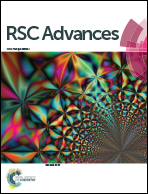Solution based synthesis of Cu(In,Ga)Se2 microcrystals and thin films
Abstract
Herein, for the first time, we report the synthesis of quaternary Cu(In,Ga)Se2 microcrystals (CIGSe MCs) using a facile and economical one-pot heating-up method. The most important parameters such as reaction temperature and time were varied to study their influences on the structural, morphological, compositional and optical properties of the MCs. Based on the results, the formation of CIGSe was initiated from binary β-CuSe and then converted into pure phase CIGSe by gradual incorporation of In3+ and Ga3+ ions into the β-CuSe crystal lattice. As the reaction time increases, the band gap energy was increased from 1.10 to 1.28 eV, whereas the size of the crystals increased from 0.9 to 3.1 μm. Besides, large-scale synthesis of CIGSe MCs exhibited a high reaction yield of 90%. Furthermore, the CIGSe MCs dispersed in the ethanol was coated as thin films by a drop casting method, which showed the optimum carrier concentration, high mobility and low resistivity. Moreover, the photoconductivity of the CIGSe MC thin film was enhanced by three order magnitude in comparison with CIGSe NC thin films. The solar cells fabricated with CIGSe MCs showed the PCE of 0.59% which is 14.75 times higher than CIGSe NCs. These preliminary results confirmed the potential of CIGSe MCs as an active absorber layer in low-cost thin film solar cells.



 Please wait while we load your content...
Please wait while we load your content...